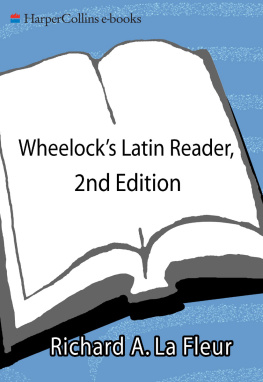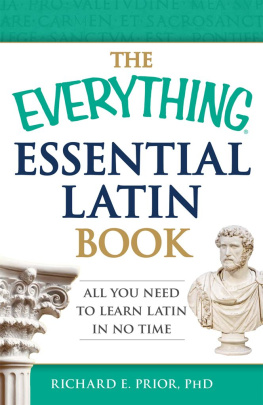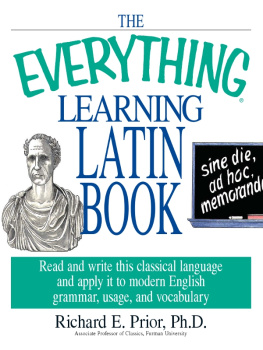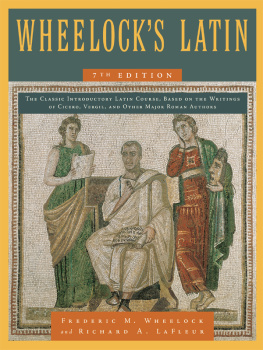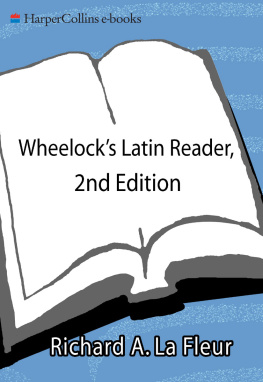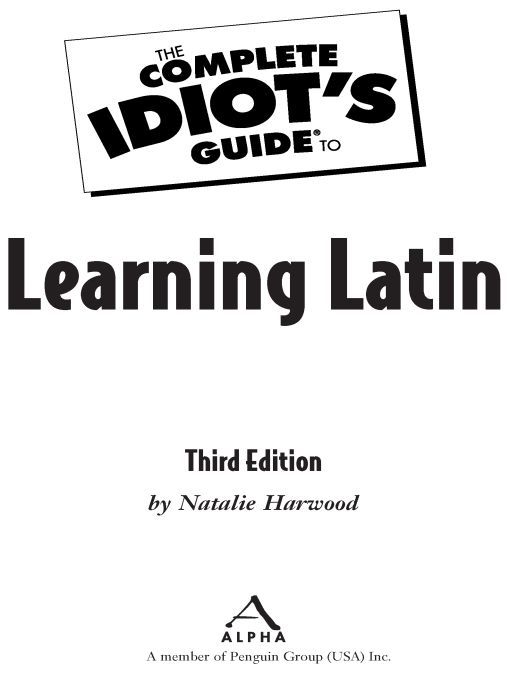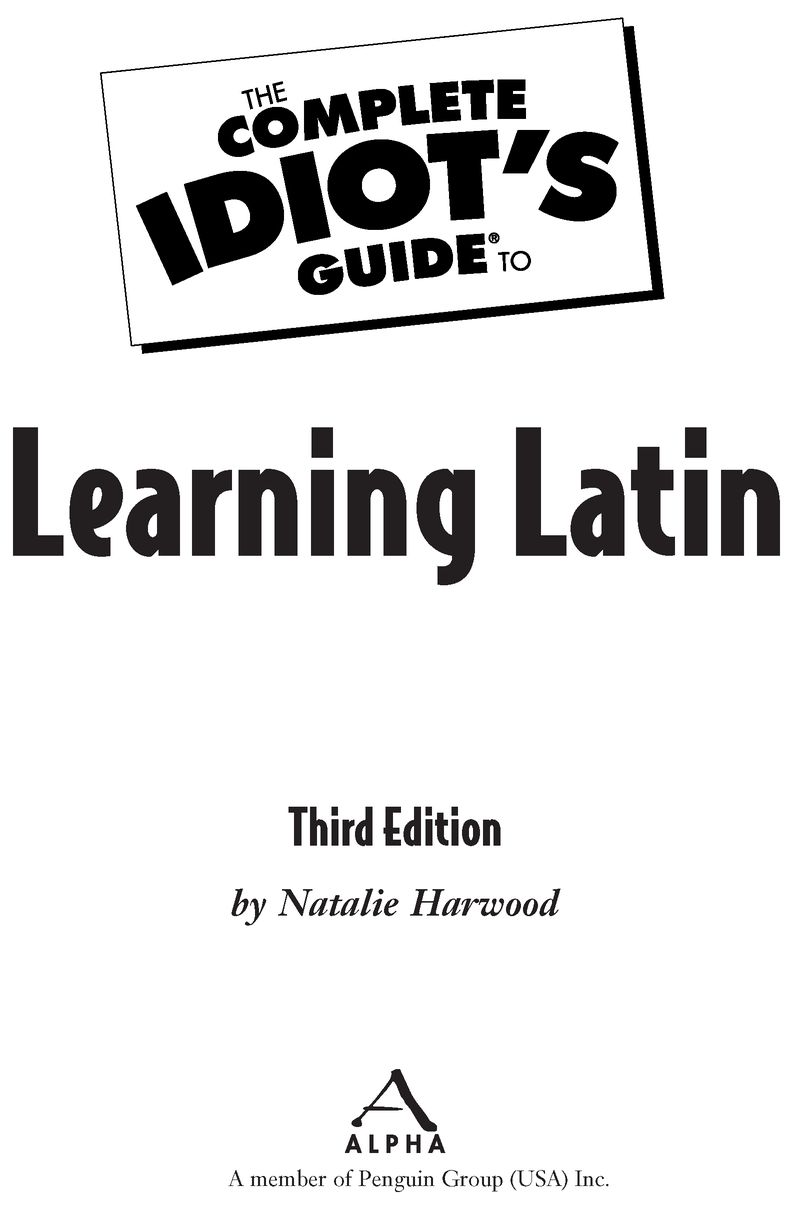Table of Contents
To my mother, who always believed I would write a book.
To my children and grandchildren, who continually shape my life in wonderful ways.
To my sister, who called me from New York.
To my brother and sister-in-law, for their great sense of humor.
To Miss Dorothy Rounds, who would have wanted to be known for publishing An Index to
Festschriften. For me, however, she will always be the dedicated Arlington High School Latin teacher
who had a dress with sleeves like bat wings and who fell into the wastebasket while reading from
Apollonius Rhodius.
Foreword
The Complete Idiots Guide to Learning Latin, now in its third edition, is a new and fresh approach to a subject of practically unlimited possibilities. While producing a substantial survey of grammar and vocabulary in an amusing and attractive format, Natalie Harwood has liberated Latin from its narrow focus on a handful of ancient authors and texts. This guide introduces the reader to the whole range Latin has occupied in Western civilizationfrom antique myths to modern medicine and law, from generals and emperors to comebacks and mottoes, from love poetry and drinking songs to hymns and Christmas carols. Natalie Harwood shows the pervasiveness of Latin in the Western world, a pervasiveness that continues in the twenty-first century in the numerous professional vocabularies that depend on Latin.
Although all the major components of Latin syntax and morphology are included, they are usually followed by a But hey, forget all that! All you really need to remember is Ms. Harwoods many years of experience teaching Latin show in her deft presentation, in an accessible and fun manner, of one of the most feared topics in the curriculum. Various sidebars give clever mnemonics for vocabulary, brief historical and cultural sketches, study tips, and Hysterias Herstoryaccounts of famous Roman women to balance the picture of the mostly male history. All this supplementary material has been chosen carefully to integrate the grammar and vocabulary with the study of Roman and medieval culture. From the beginning to the end, Natalie Harwoods exuberant sense of humor makes the whole enterprise a delight.
Answers to all exercises and Latin translations are given in a key so readers can work through the text by themselves and check their own work. A complete glossary of the 2,400 Latin words introduced in the text is complemented by an English-Latin glossary to help readers write their own compositions. There is something here for everyonethose who studied Latin years ago and would like to revisit the old friend, those who never studied Latin and thought they had missed their chance, and even Latin teachers who are looking for fresh ideas and approaches to this rich subject.
The presentation moves sensibly from words to phrases to sentences to interesting selections from ancient and medieval authors that show how very modern the issues and problems that puzzled generations of Latin writers are. Authors of selections include Terence, Caesar, Cicero, Vitruvius, Pliny, the Vulgate, Augustine, and many more.
If you thought Latin was a dead language that required more effort than it could be worthTolle! Lege! (Take! Read!). The Complete Idiots Guide to Learning Latin was written for you!
Stephen A. Nimis
Professor of Classics
Miami University
Oxford, Ohio
Introduction
Latin, a dead language? Doctors use Latinvertebra, fibula, humerus, patella. Lawyers use Latinnolo contendere, habeas corpus, res iudicata, subpoena. Architects use Latintympanum, basilica, post, lintel. You use Latin when you buy a carAurora, Saturn, Maximawhen you write a research paperibid, idem, et al.when you exchange moneyannuit coeptis, e pluribus unumwhen you go to churchmea culpa, pater nosteror when youre just sitting around the house watching old movies such as Spartacus or Julius Caesar.
Perhaps you want to know what the Latin actually means. Perhaps you want to read the words of Caesar, Cicero, and other writers from 2,000 years ago. Perhaps youre in Latin I class and are wondering how to ace it. Perhaps youre an advanced Latin student but were sleeping when everyone else learned the relative pronouns.
In any case, reading this book will help you review or learn from scratch the language that is basic to all the Romance languages. In the process you will learn history, improve your vocabulary, freshen up your English grammar, and maybe even have a little fun!
This Is Not (Shudder) a Latin Textbook!
This book is based on the premise that you can learn a language as an adult by imitating how you learned a language as a child. If you were a fairly normal child, you began speaking English (or your native language) one word at a time. Like most children, you did not come out with complete sentences at the age of 12 months. And you certainly didnt learn English by reciting grammar rules or memorizing lists of words.
So you approach learning Latin the same way. You start with single words; then combinations; then phrases, clauses, sentences; and finally paragraphs. I have tried to include words that have useful derivatives, words you can use at work, in the board-room, or at a boxing match (quite a pugilist!).
Ive tried to group words in interesting ways, rather than simply alphabetically. Nouns are listed as living things, places, and inanimate things. Verbs are grouped into very physical, slightly active, and couch potato states of being.
In broad strokes, heres what youll find in this book:
Part 1, Frequently Asked Questions, gives you useful rationalizations for not knowing Latin. The history of Latin is explained, and simple pronunciation guides help you speak Latin correctly. Finally, I give you plenty of reasons for learning Latin, just in case you have a dimwitted friend who laughs at you for reading this book. Remember, stulti Latinam linguam rident (fools laugh at the Latin language).
Part 2, Whats in a Word? starts you off with handy nouns you can use every day. You learn about number, gender, and case (only the nominative and genitive), and you get lots of practice. Then you learn verbs (so your nouns can do something), objects, and adjectives so you can describe your nouns. After a few more necessities such as pronouns and time and place wordsand lots of practiceyou are ready to move on.
Part 3, Expressing Yourself in Latin, expands your capabilities with infinitive phrases, prepositional phrases, and the notorious ablative absolute. Then we jump into relative clauses, purpose, and result clauses. The last two chapters of this part put to work all the previous lessons and give you a chance to review your English grammar. Remember complex, compound, and simple sentences?
Part 4, Reading LatinSelections from Ancient Authors, gives you, at last, some original Latin. Selections from Pliny, Cicero, Julius Caesar, Terence, and Vitruvius get you started reading authentic Latin and learning something about people who lived 2,000 years ago.
Part 5, Coping With Latin in the Modern World, explores the Latin words and expressions that people working in the everyday world today experience. The historical background is explained and the actual meaning of some of the Latin words will leave you saying, I always wondered what that really meant! Lawyers, scientists, doctors, and even stay-at-home moms will find this section relevant.





